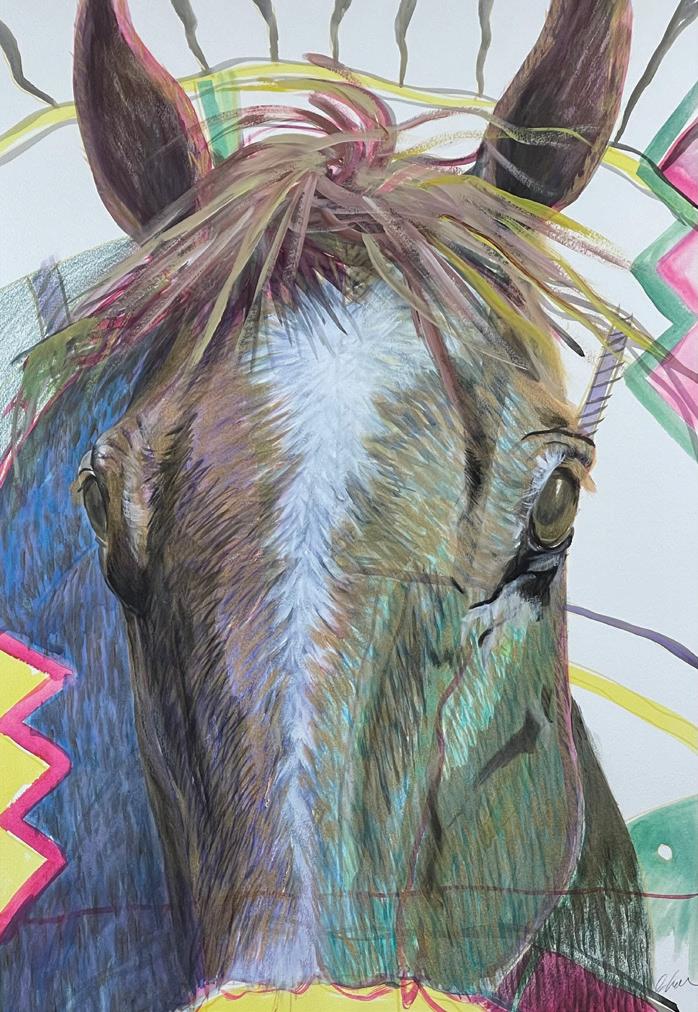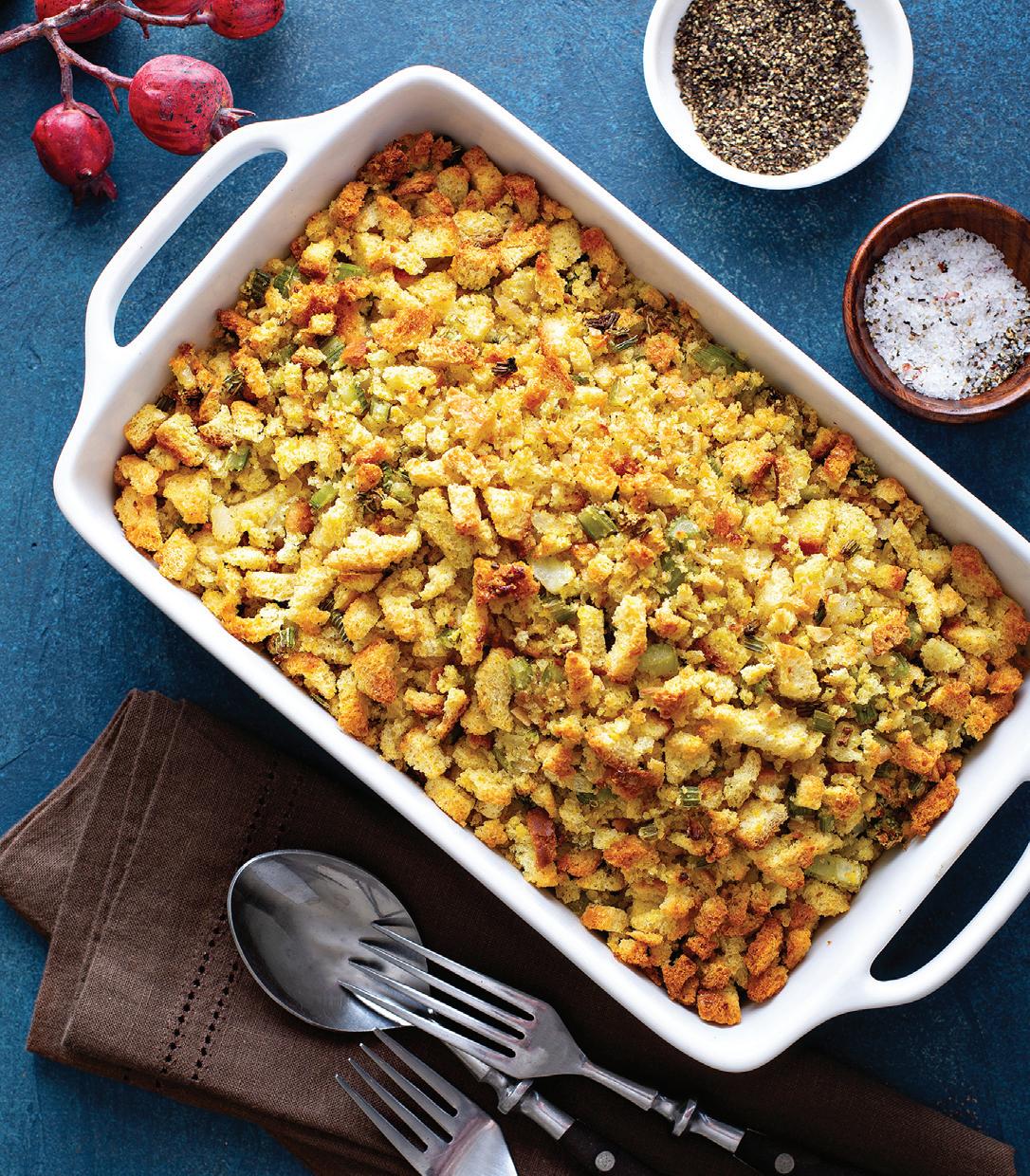
4 minute read
The Stuff(ing) of Legends




TRADITIONS ★ by MATT JAEGER
A Brief History of the Best Part of Thanksgiving
N THINKING AND WRITING ABOUT THE UPCOMING Thanksgiving holiday, my thoughts should be directed toward what that compound word dictates; I should be giving thanks. My mind should be filled with counted blessings, taking stock of the comforts provided by my family and friends, and, despite any travails and hiccups, my life is truly a horn of plenty. I
Yet my mind is not doing these things.
Instead, whenever I think about Thanksgiving, I think about food, and more specifically, the stuffing. Ahh stuffing! and I say this with the full realization that it is an odd portion to think about, particularly considering all the wonderful foods that grace a Thanksgiving table. After all, what is stuffing but sodden bread?
Sure, you can doctor it up with sage, celery, apples, sausage, and oysters. You can float it in gravy. You can substitute farmhouse white breads for brown breads, cornbread, rice, or oats. You can even call it something else: farce (the old French term), forcemeat (the English bastardization of the French term), or dressing (a relatively recent term that primarily refers to stuffing outside the bird). Whatever you do to it, for most of us, it is still just a gloppy mush.
And yet, what delicious mush it is! Stuffing is, hands down, the best part of the Thanksgiving meal.
While it may seem peculiar to proclaim an affinity so loudly for stuffing, I am not ashamed. In fact, I venture that I am not alone. Many of you, ravenous readers, doubtlessly feel the same way. Fellow Paducahan, author, and bon vivant, Irvin S. Cobb was in enthusiastic agreement. The man enjoyed his stuffing. Cobb was a gourmand, a lover of the gastronomic, and in his book Bill of Fare, Cobb wrote, “He [the turkey] had not been stuffed by a taxidermist or a curio collector, but by the master hand of




one of those natural-born home cooks—stuffed with corn bread dressing that had oysters or chestnuts or pecans stirred into it until it was a veritable mine of goodness, and this stuffing had caught up and retained all the delectable drippings and essences of his being.”
My sentiments exactly, Irvin.
And may I add that while I certainly eat the rest of the Thanksgiving meal with such thankfulness as to be akin to virtue, the stuffing is unabashedly devoured.
The practice of stuffing is ancient. The first known recipe comes from a Roman cookbook called Apicius dating back to 200 or 300 A.D. in which a variety of consumables (chicken, rabbits, and pig) are advisedly stuffed with a variety of other ingredients (vegetables, spices, and organ meat). With the Romans being so creative with their stuffings so early in history, one can only imagine the scope of stuffing ingredients before and since. Recent years have seen an increase in turkeys stuffed, not with vegetables and breads, but with other fowl. It is called a turducken and consists of a chicken stuffed into duck then stuffed into a turkey. While this chimeric delicacy seems innovative, it is hardly new. The practice of stuffing animals with other animals is old as well. An Andalusian recipe from the 13th century advises stuffing a ram with a potpourri of small birds. In 1807, a French gastronomist, Grimod de La Reynière, recorded the following dish: a bustard stuffed with a turkey, a goose, a pheasant, a chicken, a duck, a guinea fowl, a teal, a woodcock, a partridge, a plover, a lapwing, a quail, a thrush, a lark, an ortolan, a bunting, and a garden warbler. He called this his “roast without equal,” and it must be, unless one believes the stories of the traditional Bedouin wedding feast in which cooked eggs are stuffed into fish, then the fish into chickens, then the chickens into sheep, then the sheep into a camel. Surely, if true, this is the pinnacle of all stuffings! That being said, I probably wouldn’t eat it. The preparation of camel is laborious, and I find the flavor a bit gamey.
Despite all these variations, there is still room for experimentation, for a new chapter in the book of stuffing. Western Kentucky’s history and affinity for pork barbeque, combined with Thanksgiving tradition, is a place to start. Thusly, I propose the following recipe for Western Ken-turkey (as it must be called):
Buy several barbeque sandwiches from your favorite barbeque joint (preferably pressed flat and dotted with hot sauce). Chop the sandwiches up (bun and all) and stuff them inside a turkey along with any other seasonings you may desire. Roast the stuffed turkey and serve with gravy.















